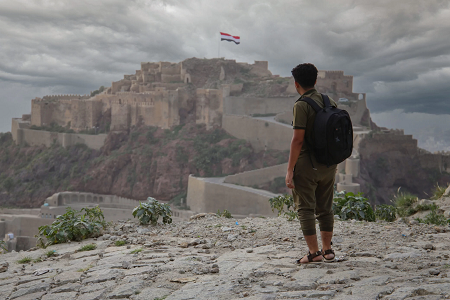Marginalized in Yemen: Struggle for Basic Rights amid Displacement and Conflict

Marginalized in Yemen: Struggle for Basic Rights amid Displacement and Conflict
Amid Yemen`s ongoing conflict, racialized and marginalized groups face precarious conditions worsened by forced displacement and the comprehensive collapse of infrastructure and basic services. Living in dire poverty before the current civil war, foreign occupation and armed conflict, the most afflicted are those Muhammashin, also traditionally known also as al-Akhdam (servants, in Arabic), who descend from either African slaves or 6th-century soldiers from the Kingdom of Aksum. Deprived of their rights to land and housing, these groups endure additional hardships, including limited access to water and food, as well as discrimination within displacement camps.
As the civil conflict has intensified over recent years, particularly the decade since the March-2015 Saudi-led bombing campaign. The cities most affected by conflict, such as Aden, Taiz and Hudayda, had large concentrations of Muhammishīn. In Taiz, Saudi-led coalition airstrikes hit Muhammishīn neighborhoods very early, and they were among the first to be internally displaced. The northern city of Saada also had a concentration of Muhammishīn who were displaced to other governorates, such as Amran, when Saada was heavily bombed by the coalition in April 2015. makes their plight one of the most urgent issues on the human rights and humanitarian agenda. Their number is divergently estimated at 500,000 to 3.5 million,
Dual Deprivation in Displacement Camps
Displacement camps in Yemen serve as temporary shelters for tens of thousands of marginalized individuals forced to leave their homes and lands. However, these camps, meant to provide protection and assistance, suffer from severe shortages in essential resources and services, such as clean water and adequate food. Field reports indicate that, amid institutionalized racism, resource distribution is often inequitable, with marginalized groups facing discrimination based on class or ethnicity, further isolating them in these overcrowded and already fragile spaces. Remaining ‘stateless’ for generations, many Muhammishīn lack even the documentation needed to prove their identity.
Water and Food Crises: A New Dimension of Discrimination
With Yemen’s acute water scarcity, displacement camps face dire conditions due to weak infrastructure and the absence of comprehensive humanitarian planning. Accessing water poses a significant challenge for marginalized groups, many of whom must travel long distances to reach unsafe sources, exposing them to both health and social risks.
Regarding food, marginalized individuals are often at the bottom of the priority list during humanitarian aid distribution. Testimonies reveal that some groups in the camps are denied food rations, or receive insufficient quantities, deepening their suffering and threatening their food security, especially given the high malnutrition rates across the country.
The Right to Land and Housing: The Roots of the Crisis
The loss of land and housing is one of the most prominent aspects of the marginalized communities` suffering in Yemen. Many lack legal documents proving their ownership of the land they inhabit. This situation is often used as a pretext to exclude them from resettlement or compensation programs. Reports also indicate that other displaced persons discriminate against the Muhammishīn accessing displacement camps. During displacement, numerous marginalized families remain uncertain about their future, lacking the necessary support to rebuild their lives in safe and stable locations.
Toward a More-equitable Solution
Improving the conditions of marginalized groups in Yemen requires a comprehensive approach focused on equal access to basic rights and resources. To achieve this, several effective interventions can be adopted:
1. Developing Aid Distribution Mechanisms: Transparency and fairness must be ensured in the distribution of resources within displacement camps, prioritizing the most vulnerable groups, including marginalized communities.
2. Enhancing Legal Protection: Efforts should be made to document marginalized groups’ rights to land and housing through legal programs aimed at removing the barriers they face in proving ownership.
3. Empowering Local Communities: Encouraging displaced communities to form local committees representing marginalized groups to participate in decision-making regarding resource distribution and camp management.
4. Increasing Humanitarian Support: International and regional organizations must pay special attention to marginalized groups by allocating food and water programs tailored to their urgent needs.
Conclusion
Improving the conditions of marginalized groups in Yemen requires moving beyond traditional relief approaches to rights-based policies that ensure equitable access to essential resources. The continued suffering of these groups is not only a consequence of the conflict, but also a reflection of long-standing social injustice and exclusion. Addressing these issues is a critical step toward achieving equality and stability in a country burdened by war and displacement.
Photo: The remains of the Ta`iz Citadel. Source: Ahmed al-Basha.
|